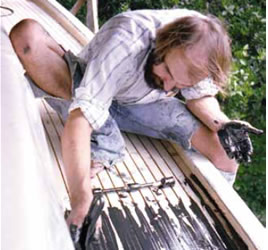
Photo courtesy of Cabo Rico
If you were the young, newly married Ben Harrison, hanging out in San Francisco in 1973 with your beautiful art graduate wife, and you suddenly found yourself heir to $32,000-well, youd be excused for being seduced by teak trailing boards, clipper bows, and bowsprits. It was the 1970s after all, when a good bit of America experienced a collective lapse of judgement.
Sure, you had your law degree, but whod blame you for skipping a third try at the California Bar Exam to travel to the jungles of Central America to build a boat? The infinite possibilities of youth, above all else, intoxicates.
So it was that Helen and Ben Harrison, partially inspired by a thrilling and miserable Gulf Coast delivery aboard a friends sloop, decided to escape to Costa Rica in a worn-out Pontiac with their Irish setter and a set of plans from W.I.B. Bill Crealock.
Outside of San Jose, an inspired entrepreneur named John Schofield and a crude factory optimistically dubbed Fibrotecnica was giving birth to a boat that managed to incorporate most-if not all-of the aesthetic elements of a 1970s-era cruising boat that caused ordinary people to take leave of their senses. There, among the expatriate Americans with their tax dodges, smuggling rings, and get-rich schemes, the Harrisons crazy dream to re-finish one of the Fibrotecnica-built Crealocks (then known as the Trans Am 36, and later as the Tiburon 36) as an aft-cockpit design didnt seem so crazy.
We knew we wanted to do something special, writes Ben Harrison, in his memoir, Sailing Down the Mountain. Special indeed. Harrisons aft-cockpit Crealock eventually became the prototype for the Cabo Rico 38, the boat reviewed in this issue.
Though far from perfect, the Cabo Rico 38 is the kind of boat that inspires a madness that Ive spent a good deal of time trying to figure out-because Im a victim myself. It is no doubt something deeply embedded that pushes one over the edge and toward the sea. And old clipper bows-the sort you see on old CTs, Garden designs, and Gozzards-have a hold on the American psyche like few other shapes. Witness how even the most efficient cruising underbodies coming out of Maine still cling to traditional lines.
Whatever the cause of this disease, we can be thankful for the result. Ben and Helens stroke of mad genius inspired countless cruising dreams, some saner than others. And in case you were worrying about long-term effects, I think were all pretty safe. Today, Ben and Helen run the Harrison Art Gallery in Key West, Fla. The last time I checked, they were doing just fine.
































